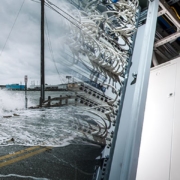6 steps to the perfect disaster recovery plan
None of us like to think that a disaster is imminent. Unfortunately, it’s not always possible to predict when one will hit. For the majority of business owners, a major disaster won’t happen. But failing to prepare for one means you’re inviting a world of stress and financial challenges on yourself.
Fortunately, a well-formed disaster recovery plan can make all the difference. As a constantly evolving piece of work, your plan is there to cushion you against disasters. If you’re not sure how to create one, here are some steps for doing so.
Identify potential disasters
There’s no sense in creating a disaster recovery plan if you don’t know what you’re recovering from. One common disaster that’s a potential threat to everyone is your servers being destroyed as a result of bad weather. Another is a significant data loss as a result of ransomware.
Disturbingly, around 71 percent of ransomware attacks are targeted at small to medium-size businesses.
In addition to identifying potential disasters that could affect all businesses, think about those that are unique to your industry. For example, if you work in the medical sector, this could mean a significant loss of confidential information.

Decide on disaster criteria
Setting a disaster threshold that’s too low is likely to create unnecessary work for you and your employees. For example, you may experience an adverse weather event that only wipes out two of your computers. Although this is frustrating, it doesn’t constitute a disaster. A more reliable benchmark would be an adverse weather event that wipes out all of your data, or most of it.
Deciding on disaster criteria helps you prevent unnecessary disruption to your business. If you begin implementing a recovery plan at the slightest inconvenience, you’re going to disrupt your daily operations. Being specific also provides your employees with guidance when you’re not there.
Find a solution for each disaster
Once you know what each potential disaster is, you need to find a solution for it. Depending on what you’re guarding your business against, you may need to find more than one.
Using adverse weather as an example again, one way to ensure you can recover from the disaster is by having a dependable data backup source. Some business owners feel comfortable having even more than one. Although the chances of bad weather affecting both data sources at the same time are very slim, they’re not completely impossible. Having three places for storing your data is a far more robust approach.
You’ll also need to think about the specifics for each solution. Using data backup as an example again, consider how often you want to back your data up. Although backing up once every 24 hours seems sensible, can you really afford to lose a day’s worth of work? Or, would it make more sense to back up once every two to three hours, so that the financial impact isn’t as bad?
Determine who’s involved
Your disaster recovery plan isn’t a standalone system that depends on technology alone. It involves both internal and external personnel. You need to identify who is playing various roles in your plan and then document their participation. And as your staff are likely to take breaks or sick leave at some stage, you may want to identify some backup personnel too.
It’s important to discuss your plan with each person and clarify what their roles are. Give them the chance to ask you questions and encourage them to understand the roles that others play too. You should always remain mindful of the fact that staff who move to different departments or find new jobs will require replacing. When you do replace them, make sure others are aware of the changes and update your disaster recovery documents accordingly.

Choose your data recovery solutions
For most businesses, data recovery will act as the cornerstone of their disaster recovery plan. It’s important to take this aspect of your plan seriously, as the average cost of a data breach is $40-million per 1-million records.
A lot of businesses find themselves choosing between onsite, offsite, and cloud-based data recovery. Offsite and cloud-based certainly come with more perks than onsite. Although a backup source onsite does have its advantages, it doesn’t protect you against adverse weather events.
Many business owners now choose cloud backup, as it comes with advantages outside of data recovery. For example, your employees can access data from anywhere, giving them the chance to work remotely. Additionally, in the event of a disaster, it means you can start recovering immediately. You don’t need to wait for a physical premises to become available, which means you minimize financial losses. Around 94 percent of all enterprises use the cloud, which demonstrates how popular it is.
If you choose an offsite recovery center, make sure it benefits from plenty of physical protection. Waking up to find that your backup data source has become redundant is frustrating to say the least.
Determine what your procedures are
From the moment a disaster has been identified, those who are involved in recovering from it need to know what steps to take next. Even if a lot of your recovery is automated or outsourced, documentation and monitoring will become necessary. There’s no sense in executing a recovery plan when you’re not monitoring its progress.
It’s wise to find ways to validate your efforts too. Your plan will probably have multiple steps, but you need to know how to measure whether they’re successful. Once you have criteria in place, you’ll know when to move onto the next phase of your plan.
Above all, you need to remember that your disaster recovery plan is a fluid document. As potential disasters change, so should your plan. Make sure you schedule dates for reviewing it and you won’t find yourself floundering in the midst of a disaster.















